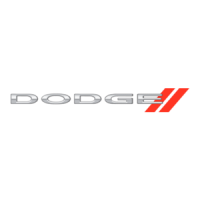
Do you have a question about the Dodge 2009 Challenger SRT8 and is the answer not in the manual?
| Brand | Dodge |
|---|---|
| Model | 2009 Challenger SRT8 |
| Category | Automobile |
| Language | English |
Important safety notices and warnings to prevent accidents or vehicle damage.
Warning about potential safety risks from vehicle modifications or alterations.
Explanation of the keyless ignition system, Fob with Integrated Key, and WIN.
Details on the Sentry Key Immobilizer System to prevent unauthorized operation.
Description of how the vehicle security alarm monitors and protects the vehicle.
Functions of the RKE system for locking, unlocking, and trunk release.
Instructions on how to activate and deactivate the panic alarm.
Procedure for programming new Remote Keyless Entry transmitters.
Overview of the voice-activated, hands-free communication system.
Instructions on using voice commands to control vehicle systems.
Guide to using the cruise control system for maintaining speed.
Information on programming and using the HomeLink system.
Operation of the power sunroof, including express and pinch protect features.
System overview, including how to access and use its features.
List and explanation of various messages displayed by the EVIC system.
Details on accessing and using vehicle performance statistics.
Guide to customizing vehicle features via the EVIC.
Essential steps before starting the vehicle, including seat belt and mirror adjustments.
Description of the driver-interactive transmission for manual gear shifting.
Advice on acceleration, traction, and handling in slippery conditions.
Precautions and recommendations for driving through water.
Explanation of how ABS enhances vehicle stability and brake performance.
Information on ESP, TCS, BAS, and HSA electronic brake control features.
How the TCS system monitors wheel spin and applies brake pressure.
How BAS optimizes braking capability during emergency maneuvers.
How HSA assists the driver when starting on a hill.
Explanation of ESP's function in enhancing directional control and stability.
Information on vehicle load limits and recommended tire pressures.
The importance of proper tire inflation for safety and vehicle operation.
Location of information for proper cold tire inflation pressures.
Explanation of the TPMS warning system for low tire pressure.
Crucial safety precautions to prevent carbon monoxide poisoning.
Guidance on determining and adhering to the vehicle's load carrying capacity.
Dangers and consequences of overloading vehicle components.
Steps to properly load the vehicle, including weight distribution.
Instructions for operating the hazard warning flashers during an emergency.
Actions to take to reduce overheating potential in various driving situations.
Instructions and warnings for using the TIREFIT tire repair system.
Detailed safety precautions and procedures for jump-starting a vehicle.
Methods for freeing a vehicle stuck in mud, sand, or snow.
Explanation of the OBD II system and its function in monitoring vehicle systems.
Procedures for checking and changing engine oil.
Procedures for checking coolant level, condition, and maintaining the system.
Overview of the oil change indicator system and service reminders.
Detailed schedule of required maintenance services based on mileage or time.
Procedure for reporting vehicle safety defects to NHTSA and the manufacturer.











